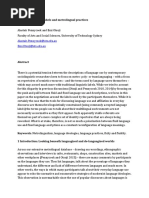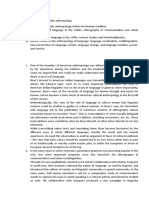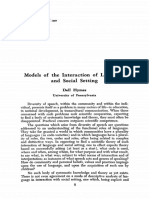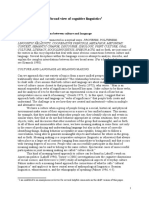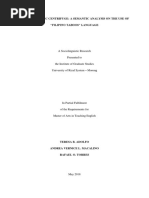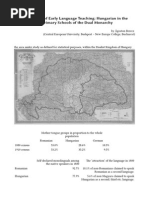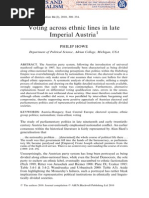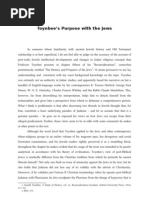Linguistic Fetish
Linguistic Fetish
Uploaded by
Berecz ÁgostonCopyright:
Available Formats
Linguistic Fetish
Linguistic Fetish
Uploaded by
Berecz ÁgostonOriginal Description:
Copyright
Available Formats
Share this document
Did you find this document useful?
Is this content inappropriate?
Copyright:
Available Formats
Linguistic Fetish
Linguistic Fetish
Uploaded by
Berecz ÁgostonCopyright:
Available Formats
Helen Kelly-Holmes
5 Linguistic fetish: The sociolinguistics of
visual multilingualism
Abstract: Linguistic fetish refers to the phenomenon of using languages for symbolic (fetishised) rather than utility (instrumental-communicative) purposes in
commercial texts. In such a context, form takes precedence over content, which
may or may not be relevant to, or understood by, the target audience. In this
chapter, building on and extending my previous work in this area (Kelly-Holmes
2010, 2005, 2000), I explore linguistic fetishization as a sociolinguistic practice,
using a range of examples from a variety of media and contexts. The chapter starts
by examining current thinking on visual multilingualism in sociolinguistics, before
moving on to examine the commodification of such visual language in contemporary consumer culture using the notion of linguistic fetish. I then go on to examine
three cases of linguistic fetish in visual multilingualism the foreign language
visual; the minority language visual; and visual English and attempt an assessment of their sociolinguistic implications.
1 Introduction
While visuality is becoming increasingly central to contemporary consumer culture
and marketing as a practice reflects this intense engagement with visuality (de
Burgh-Woodman and Brace-Govan 2010: 188), considerations and analyses of visual consumption or visual marketing do not generally consider the role of language in this process (cf. for example Schroeder 2006). This is despite the increasing use of language for its visual qualities and or symbolic purposes rather than
for communicative or instrumental functions in contemporary consumer discourses such as advertising. Likewise, in the study of language, a preoccupation
with its visual materiality is a relatively recent phenomenon. In this chapter, I look
at what I term visual multilingualism, namely the use of languages primarily as
images, with an analysis that is informed by sociolinguistics, the study of language
use in its social context. I start by examining current thinking on visual multilingualism in sociolinguistics before moving on to examine the commodification of
such visual language in contemporary consumer culture using the notion of linguistic fetish. I then go on to examine three cases of linguistic fetish in visual
multilingualism the foreign language visual; the minority language visual; and
visual English and assess their sociolinguistic implications.
136
Helen Kelly-Holmes
2 Visual multilingualism
While the system of language has long been an object of study, with lexicographers, grammarians and syntacticians attempting to codify and record the relations between words, spellings, structures and meanings, attention to language as
a social phenomenon is a relatively new phenomenon. It was only in the latter
half of the 20th century that there was a decisive move away from studying language primarily as an objective, inanimate phenomenon to studying it in relation
to its speakers, and more precisely to different types of speakers (differentiated by,
for example, location, social class, educational background, gender, age) (cf. Spolsky 2009 for an overview here). From this social turn in the study of language
grew the contemporary discipline of sociolinguistics, which itself has also moved
away from its original focus on modernist constructs such as class to consider all
dimensions of language in use, including the issue of concern in this chapter,
namely visual uses of language.
Probably the most well-known and widespread approach to analysing visual
multilingualism is the linguistic landscapes approach, developed by Landry and
Bourhis (1997) and advanced by many scholars since (e.g. Shohamy and Gorter
2009). The concept of linguistic landscape represents an attempt to account for
the visual presence of particular languages in the public space as a reflection of
and contribution to ethnolinguistic vitality, i.e. the relative strength of these languages in terms of their status and functions as living languages within their
immediate speech communities and beyond, particularly in minority language spaces and sites of complex multilingualism. The technique involves documenting
visual multilingualism (and also monolingualism) by systematically counting the
presence and frequency of languages on public signs in various domains. As such,
linguistic landscape analysis represented a departure from a focus on text semantics in the study of language use, since content and/or meaning were not initially
important, a focus was on the visual presence or absence of particular languages
in particular spaces.
The idea behind the linguistic landscape approach was that the visibility of
particular languages could reflect their relative position in the sociolinguistic hierarchy, and that a greater visibility of one particular language could send the message that this was the dominant language. Thus, the visibility and visual positioning of particular languages could be used as a way of revealing common-sense
ideologies about language(s) that are prevalent in a particular society. As Heller
(2008: 518) tells us, our ideas about language are not neutral; we believe what
we believe for reasons which have to do with the many other ways in which we
make sense of our world and make our way in it, and the languages we see
around us everyday are considered to be part of this, whether or not we speak
them or understand them or even recognise them, beyond an acknowledgement
that they are not our language. The investigation of visual multilingualism, in
Linguistic fetish: The sociolinguistics of visual multilingualism
137
the form of linguistic landscape analysis, can thus be seen to be informed by and
contributing to understanding language ideologies, which are considered to be
the discourses that attribute value to linguistic forms and practices, along with
the processes of constructing social difference and social inequality with which
they are associated (Heller 2008: 518) in contemporary and historical perspective.
A further indication of the power of visual multilingualism is the fact that
status planning initiatives in minority language spaces have both responded to
and initiated linguistic landscape studies by reversing what is seen to be an imbalance in visual multilingualism and/or monolingualism by introducing legislation
which requires that the minority language is printed on public signs in addition
to the relevant dominant language (e.g. Wales, Ireland) or that it is to appear
on its own (e.g. Quebec). Linguistic landscape studies have not just concerned
themselves with the presence and frequency of languages on public signs, but
have also focussed on the visual positioning of different languages on the signs,
and, again, this notion that the positioning of languages is important has also
been taken up by language planners, who now often require that the existing
visual hierarchy is reversed by placing the minority language on the top of the
sign above the dominant language (e.g. in Ireland, where Irish is placed above
English) (cf. Shohamy and Gorter 2009 and Gorter, Marten and van Mensel 2011,
for examples of studies). Clearly, then, such approaches represent a concern with
the material properties of the printed language, rather than with what is being
communicated by the printed language, since, in many cases, the content is the
same (e.g. on road signs, where the same place name is given in parallel versions).
Linguistic landscape analyses have developed considerably since the pioneering study of Landry and Bourhis (1997) (for an overview of the development of
linguistic landscape research, cf. Jaworski and Thurlow 2010). In a recent volume,
Jaworski and Thurlow (2010) advocate a move from focusing on the linguistic
landscape to considering the semiotic landscape, in order to emphasize the way
written discourse interacts with other discursive modalities: visual images, nonverbal communication, architecture and the built environment (Jaworski and
Thurlow 2010: 4). They are interested in defining landscape as a way of seeing
(Jaworski and Thurlow 2010: 4), which is subject to a number of competing
scopic regimes or visual subcultures (Jay 1998: 4 in Jaworski and Thurlow 2010:
4). This implies that how we see is mediated by social and cultural practices and
structures. This also applies to language: in the same way that how we hear language in terms of hearing and differentiating accents, dialects and other languages is mediated by cultural practices and social structures, how we see
another language or variety depends on the particular scopic regime to which
we are subject; our gaze is dependent on our particular habitus in Bourdieus
terms (1991). Thus, how we see language is pre-formed and then either reinforced
or challenged by the visual multilingualism or monolingualism we encounter on
a daily basis hence the desire by language planners to reverse existing visual
hierarchies in order to change language ideologies within the particular habitus.
138
Helen Kelly-Holmes
Jaworski and Thurlows (2010) approach reflects a new focus in sociolinguistics
on multi-modality, in recognition of the essentially multimodal nature of all
human meaning making. Multimodality, here, is about recognizing that language
is not at all at the centre of all communication (Iedema 2003: 39). Thus, it is not
just changes in our environment, economy and technology, which are leading to
greater multimodality, but a recognition of meaning (and of language) as multimodal. This is quite a radical mainstreaming, since it appears to be taking the focus
off language as the immediate object of study. This means on the one hand that
our sociolinguistic environment is experienced as increasingly multi-modal while,
at the same time, there is also a recognition among sociolinguists that far more
linguistic encounters are multi-modal than was previously considered the case in
analyses which looked at speech and writing without considering in full the existence, impact and inter-connectedness of other modes, what Iedema (2003) terms
the material and historicized dimensions of representation (Iedema 2003: 50).
Thus, the way a piece of language looks is also a mode of meaning, not just the
semantic meaning of what it is referring to (cf. Kress and Van Leeuwen 2001, 2006).
In addition, the sociolinguistic techniques of studying linguistic phenomena
primarily experienced and documented as verbal practices have increasingly been
applied to written language also. For example, Eastman and Steins (1993) concept
of language display, which looks at the conscious use of a language not linked
to the ethnic identity of the speaker. Eastman and Stein (1993) argue that language
display is in fact most successful where there is limited or even no knowledge of the
language being displayed on the part of the speaker. Language display represents
symbolic rather than structural or semantic expression (Eastman and Stein 1993:
200), with the focus on form rather than content; what is being said, is not important, instead it is the language in which it is being said this is the effect which
the speaker is trying to achieve. Language display, while originally conceived of in
relation to oral data, has increasingly been combined with written data in the study
of visual multilingualism (cf. Kelly-Holmes (2005), and Coupland (2012) for a recent
study of the display of Welsh in the linguistic landscape of Wales). Language display is just one example of the growth of interest in spectacular uses of language,
in which a variety is begged, borrowed, or stolen by speakers who dont normally
claim it (Sweetland 2002: 515). Where previously, with the focus in sociolinguistics
firmly on stable and long-standing oral speech communities, they would have been
dismissed as idiosyncratic and insignificant, such practices have, Sweetland tells
us, recently become [] prized [in sociolinguistics literature] for their value in
understanding the social meanings that adhere to language varieties and the many
ways in which speakers can put such ideologies to work (2002: 516). Inauthentic
language (Sweetland 2002) in the form of, for example, styling the other (Bell
1999), mock language (cf. Hill 1999), crossing (Rampton 1995), and language
display (Eastman and Stein 1993) etc. are increasingly being studied as written
phenomena and for visual effects rather than just verbal effects.
Linguistic fetish: The sociolinguistics of visual multilingualism
139
3 Linguistic fetish
The concept of linguistic fetish has been developed to explain multilingualism in
economically driven displays, such as marketing and advertising texts. It is important from the outset to acknowledge that all language relations, as highlighted
above in relation to linguistic landscapes, to a greater or lesser extent reflect some
type of power relations. The local (and global) political economy of language (Gal
1989), the linguistic market (Bourdieu 1991) and other terms have been coined to
explain the interrelationship between language choice, language ideologies, and
political, social and economic power. Such relations permeate all domains of language use the school, the government, the media, the university, and even the
family not just explicitly economically driven displays and choices. Thus, while
the focus in linguistic fetish is on recognisably market-driven texts, it is important
to see linguistic fetish within a wider field of power relations.
Fetishisation involves the capacity of creating [symbolic] value a value
greater than it contains (Marx and Engels, 1959 (1894): 392). This leads to a situation where there is form without content, (Marx, 1959 (1894): 393), or where
form or symbolic meaning take precedence over content or utility. Utility in terms
of language can (crudely) be seen in terms of its communicative function, or use
as a means of communication between speakers. Where the utility value of the
language is not fetishised, then the content, the (semantic) meanings themselves
are the essence rather than the form. In linguistic fetish, the symbolic or visual
value of a language takes precedence over its communicative value, and this symbolic value is the product of existing linguistic hierarchies and regimes, ways of
seeing. As Heller points out in relation to the commodification of languages in the
current era: [] the new economys valuing of increasingly commodified cultural
artefacts and symbolic resources blurs the relationship between political symbols
and exchange goods (Heller 2008: 512)
Linguistic fetish, then, results in a highly refined version of multilingualism,
informed by a culturally determined gaze. It is a type of decoration or linguistic
colour by numbers, that has everything to do with the producers perception of
the consumers own linguistic culture or habitus, as visuality is inducted into the
service of creating a homogenous cultural perspective (de Burgh-Woodman and
Brace-Govan 2010: 177). Linguistic colour by numbers describes the very contained, prescribed parameters by which words from other languages are used in
advertisements. The choice is driven primarily not by what the word means, but
how it looks, and what associations the language may have among target addressees, and how these can be triggered by the appearance of the foreign word. Reflecting this, Harald Haarman (1989) coined the term impersonal bilingualism to
explain the occurrence of foreign words in Japanese advertising. He concluded
that their usage had nothing to do with everyday or real bi- and or multilingualism in Japan and instead were to do with exploiting symbolic associations of
140
Helen Kelly-Holmes
these languages, which were not widely understood or taught in Japan at the time
of his study, would have among the Japanese public.
The commodification of visual multilingualism can be seen as part of a wider
process of commodification of the visual: visuality is crucial to the current economic structures, and visual consumption constitutes a key attribute of an experience economy organized around attention (Schroeder 2006: 6). Jaworski et al.
(2003) have analysed the importance of linguascaping, which involves designing
the sounds and visual representations of special or unique language codes and
varieties (accents, dialects) often used for symbolic purposes (Jaworski 2003 et
al: 3), of tourist destinations to enhance the tourist experience and ultimately add
value to it. Thus, language too can form part of the tourist gaze (Urry 2002). This
realisation also changes our understanding of language. Jaworski and Thurlow
(2011) show how language has become extra-visual, while Machin and Van Leeuwen (2003) tell us that language has become a surface value as a result of global
media genres, which spread homogenous mediascapes with local languages used
simply for instrumental functions.
While linguistic fetish emphasizes the distinction between the communicative
and the symbolic or between the textual and visual in communication, it is important to remember that this differentiation is somewhat articifical, since most communication consists of both symbolic and communicative aspects. However, as
Juliane House (2003) has argued, it can be useful to try to distinguish the use of
language for communication from the use of language for identification, as
she puts it. In addition, Wee (2003: 212) also tells us that while it is obviously
possible for one and the same language to be seen as having both instrumentalist
and non-instrumentalist functions, [] it is also important to keep the functions
distinct.. Thus, while accepting the interconnection between use value and symbolic value, between the textual and the visual, linguistic fetish proposes and
recognises the primacy of the symbolic in the commodification of visual multilingualism in contemporary advertising.
We will now look at three examples of linguistic fetish. The distinctions
between them are slightly artificial, as shall become clear, and they all share commonalities in approach. However, each one highlights a particular dimension to
linguistic fetish which is interesting and useful to explore. We will start with the
first and most obvious case of linguistic fetish, linked to the discussion above,
namely the use of foreign languages as visuals; then we will move onto two
other cases, the first involving the use of visual English. Although English is of
course a foreign or second language in most parts of the world, its fetishisation
is, it has been argued, a special case that is not linked to a particular ethnosymbolic identity, unlike the use of other languages as visuals. The final case involves
the use of minority languages as visuals.
Linguistic fetish: The sociolinguistics of visual multilingualism
141
4 Foreign languages as visual
The basis for the use of the foreign language fetish, as described above, is the
understanding that an image of language may be structured only from the point
of view of another language, which is taken as the norm (Bakhtin 1981: 360).
Thus, the habitus, in Bourdieus (1991) terms, of the advertisee is the norm against
which foreignness or otherness is measured and against which the foreign or
other language is understood. It is the blank paper that gets coloured in.
Lawrence Venuti, in his study of translation, argues that the objective of translation is to erase as much as possible of the original context and to domesticate
words and concepts for the target audience, particularly in the Anglophone world.
The text should appear seemingly untranslated [by] suppressing the linguistic
and cultural difference of the foreign text, assimilating it to dominant values in
the target language culture (1994: 218). In contrast, the use of foreign languages
in advertising is not about erasure (Irvine and Gal 2000) of difference, but in fact
about the display (Eastman and Stein 2003) and highlighting of difference. As
Kress and Van Leeuwen (2006: 12) tells us, we have available the culturally produced semiotic resources of our societies, and are aware of the conventions and
constraints which are socially imposed on our making of signs, and foreign language visuals and their histories are part of those semiotic resources.
Figure 1 shows us a good example of the foreign language fetish in the screen
shot of the Stella Artois homepage, which is advertising the launch of Stella Cidre,
the Stella Artois brand being better known for its beer. The message of the adver-
Fig. 1: Homepage of www.stellaartois.com/cidre/.
142
Helen Kelly-Holmes
tisement is that Cidre (the French word for cider) is completely different to Cider
(the English word), not just linguistically, but also materially it is a completely
different drink. The main vehicle for highlighting this difference is the rendering
of the word in French for an Anglophone audience. The slogan of the campaign
is Cest cidre. Not > cider. It assumes a fairly widespread knowledge of the
basics of the French language in the Anglophone world not just as a result of
education, but also as a result of a type of mock French (like mock Spanish
cf. Hill 1999) spread by the portrayal of the French speaker in mainstream media
products in the Anglophone world. The ad also offers a phonetic guide for Anglophones (cidre => see-dra), creating a manifest intertextual (Fairclough 2001) link
with travel and tourist guides, where this kind of ethnocentric phoneticisation is
a common practice. The ad also assumes the need for this pedantic explanation
and domestication, and derives its humour from hyperbolising the ethnocentrism
and monolingualism of the Anglophone on the one hand, and the chauvinistic
exclusionary tendency of the Francophone, on the other, obsessed equally and
pedantically with the particularities of their language and culinary habits. Finally,
the link between the visual French and the product are spelled out explicitly:
Stella Artois Cidre is a premium crafted Belgian cider made with hand-picked
apples. So, the instrumental or authoritative message is delivered in English,
which further highlights the visual functions of the French language in the ad.
This example shows us how linguistic fetish is all about understanding foreignness from the point of view of ones own habitus, as part of the culturally
available repertoire of signs, to paraphrase Kress and Van Leeuwen (2006). The
foreign words on display in the text are, in Bakhtins words structured only from
the point of view of another language, which is taken as the norm (Bakhtin 1981:
360), in this case English. English is the blank canvas on which a little French is
painted. The repeated use of Cidre serves no instrumental function, since its
literal meaning is the same as that of the English word cider; instead its use shows
us how, according to Adorno: foreign words become the bearers of subjective
contents: of the nuances. The meanings in ones own language may well correspond to the meanings of the foreign words in every case; but they cannot be
arbitrarily replaced by them because the expression of subjectivity cannot simply
be dissolved in meaning (1991: 287).
Stella Artois is utilising a common practice in foreign language fetish, whereby
the name of the product in the language of the country of origin becomes the
bearer of subjective contents, in Adornos words. Familiar examples are Bier
(for German beer); Auto (for German cars); Technik (for German technology);
Kaas (for Dutch cheese); as well as all of the French vocabulary that permeates
the language of cosmetics (parfum etc.) (cf. Kelly-Holmes 2005 for an in-depth
discussion of these).
The commodification of languages in the new economy (and in the new communication landscape in Kress and Van Leeuwens 2001 terms) involves the
Linguistic fetish: The sociolinguistics of visual multilingualism
143
naturalisation, uniformisation, and objectification of social groups (and hence
their cultures, their boundaries and their languages (Heller 2008: 505). Linguistic fetish thus allows the foreign language to become domesticated in Venutis
(1994) terms as one of the available resources for sign-making in the habitus.
5 Visual English
The contemporary functioning of visual English illustrates well the dissolving of
cultural, political and semiotic boundaries, as highlighted by Kress and Van Leeuwan (2006, 2001), which both result from and contribute to the global flows of
capital, media, ideas, people and technology and their accompanying instruments
of homogenisation (Appadurai 1996), foremost among which are advertising and
the English language. English, Kachru (1996) tells us, travels via channels which
bypass the strategies devised by language planners and turns up in the most
unexpected places: in countries which are considered outer circle (Kachru 1996),
i.e. locations where English usage is the legacy of colonisation and where the
language enjoys special status in education, business and many other domains;
and, in countries which are considered expanding circle (Kachru 1996), where
English is learned as a foreign language; in situations where English is well-known
and understood; and, in situations where understanding is limited to cultural and
educational elites, or younger generations, or is confined to specific domains.
Unlike foreign languages, English has come to be ideologised as separate to
multilingualism and not indexical of any particular country or otherness.
Instead, its fetish is that of neutrality, globality etc. Wee (2010: 424) highlights
that a language may be considered neutral because it represents the language
of an Other, i.e. it is neutral because it belongs to someone else outside of the
habitus in question; however, with English, its supposed neutrality is based on
the ideology that it represents the language of no-one and simultaneously the
language of everyone: In the USA and in many other parts of the world, English
has become a neutral language, a code that can be used to avoid whatever implications may result from choosing a more identity-laden language (Callahan 2005:
284). In complex multilingual situations, English has acquired neutral status, even
though of course its usage, spread and heritage are far from neutral. So, instead
of attempting to fulfil the impossible task of addressing everyone in their own
language in for example a country like India, marketers opt for English, thus
enhancing its neutral status and fitness for this purpose (cf. Kelly-Holmes 2005;
Louw 2004; Cheshire and Moser 1994). Louw (2004) describes in detail the move
to neutral English in commercial discourse in South Africa a country with
an officially multilingual policy together with the side-lining of the negatively
connoted, though widely understood, language of Afrikaans.
Elizabeth Martin (2011) sums up the display functions of English as follows:
superior technology, chic and modern lifestyles, adventure, international and
144
Helen Kelly-Holmes
Fig. 2: Toyotas .co.jp site.
the sense of belonging to a global village (Martin 2011: 267). The example reproduced in Figure 2 illustrates many of these features. It shows the home page of
Toyotas .jp site, i.e. its dedicated site for Japanese customers. Although considered
one of the largest global brands, Toyota is Japanese owned and is widely recognised as a Japanese origin brand. In common with many brands that construct
themselves as global, Toyota operates a global gateway site (www.toyotaglobal.com), (reproduced in Figure 3) which is available in English, and which is
intended to guide consumers into their regional, national or linguistically relevant
site. The use of English on global gateway sites has become a common-sense
assumption, even for brands which do not originate in English-speaking countries,
for many of the reasons highlighted above: English is the neutral choice, the global
choice, the language of technology etc. To not have a global gateway site in English, but to have it instead in the corporations home language (in this case Japanese) or even in another international lingua franca or supercentral language (de
Swaan 2001) such as French or Spanish, without an English option would in the
contemporary era be remarkable. The use of English in the gateway site reflects a
combination of symbolic and instrumental factors: on the one hand the desire to
exploit the global fetish of visual English, on the other, the desire and necessity to exploit the distribution and functioning of English in the world today.
Japanese does appear on the site, indicating a link, not to a translated version of
the global gateway site, but to the local Japanese site. The use of English on the
global gateway site shows the interrelationship between communcative and symbolic functioning, between textual and visual concerns in language choice: English
Linguistic fetish: The sociolinguistics of visual multilingualism
145
Fig. 3: Homepage of Toyota-global.com.
is present in order to communicate with as many customers as possible; English
is also displayed to index the brands global presence and credibility.
While symbolic and instrumental concerns were reflected in the choice of English for the gateway site, the use of visual English in the .co.jp site, the site for
Japanese consumers of the Japanese brand, would appear to be completely driven
by symbolic concerns, as illustrated in the slogan accompanying the Auris (Not
authority but Auris). English appears in a number of places on the site, indexing
in instrumental and symbolic ways Toyotas global presence. For example, terms
such as Hybrid, Pick Up, and the homogenising slogan Find us on Facebook, create the global village feel, alluded to by Martin (2011). The use of
English in advertising by a Japanese company for a Japanese market is a good
example of visual English and its associated fetishes of globality. Toyota is not just
a Japanese brand for Japanese consumers, it is also a global brand for Japanese
consumers, and this global credibility is indexed by the visual English, even where
the words are not understood. Doulton (2004: 285) cites mass media as the main
source of contact with English words in Japan: nearly all gairaigo (Western loanwords) are first introduced to the Japanese public by a very small number of individuals with most Japanese people having never heard or read the word before,
and having no role to play in its borrowing. Because of this presumptuous use of
foreign words by the media, the meanings of many words used are poorly understood. As in the case of other expanding circle countries, in Khachrus terms, in
which English is spoken and learned as a foreign language, English comes via
fashion magazines and commercial advertisements of modern technology (Doul-
146
Helen Kelly-Holmes
ton 2004: 286) and for the most part, new English expressions are introduced in
the media without the audience having the necessary knowledge to understand
them. (Doulton 2004: 287). The presence of English on Toyotas Japan website is
not a reflection of an advertiser trying to service a bilingual community; instead,
it is a reflection of an advertiser displaying its globality through the display of
English, in Haarmanns words, it is impersonal bilingualism.
6 Minority languages as visual
The use of minority languages for their visuality is driven primarily by the quest
for authenticity in marketing. Jones et al remind us that two distinct strategies
may be used for claiming authenticity. One is to subject ones creative voice to the
perpetuation of tradition [] A second route to authenticity [] is to be original
and offer a distinctive approach (Jones et al 2005: 893). The minority language
fetish is clearly an example of the former. We are, Coupland (2003) tells us, in an
era that values authenticity, and language including visual language is a
means of achieving authenticity (Coupland 2003: 417). The minority language
visual is an example of language indexing authentic cultural membership (Coupland 2003: 421). This type of essentialist authenticity is, according to Coupland
(2003: 424), divisive and socio-politically dangerous notion, but it is one that is
frequently utilised in marketing discourses, particularly in the context of tourism.
Language indexing cultural membership is of course crucial in all of the examples
cited so far, particularly in terms of the foreign language fetish; however, it is
particularly pronounced in relation to the display of minority languages in tourism
discourses.
The cultural membership here could be in terms of the product or brand
itself the language is indexing the brands credibility in terms of a culture that
is different to that of the notional addressee of the advertising or marketing message. The language use could also be about positioning the brand and the consumer as having the same authentic cultural membership. Here the issue of the
relationship between the symbolic and instrumental functions of the minority language becomes once more blurred, since there may well be comprehension of the
content. However, in situations where there are no monolingual speakers of a
minority language, which is the case for many of the autochthonous European
minority languages (e.g. Irish, Welsh, Breton, Smi languages), then the choice to
use the minority language rather than the majority language is necessarily a
marked choice, driven by symbolic rather than communicative imperatives. As
Wee points out, distinguishing between instrumental and non-instrumental views
of language: a language is viewed non-instrumentally to the extent that it is seen
as forming an integral part of ones ethnic or cultural identity, and if its existence
in a community is justified in terms of its symbolic value in allowing the community members to maintain a sense of identity (Wee 2003: 211212).
Linguistic fetish: The sociolinguistics of visual multilingualism
147
Fig. 4: Homepage of Louismulcahy.com.
In a study of the labelling of souvenirs in the multilingual minority language space
of Finnish Smiland (Pietikinen and Kelly-Holmes 2011), the minority Smi language was found to work symbolically and visually towards localizing and
authenticating the product, while the instrumental functions were carried out
generally by English or other languages of wider communication (e.g. German or
French). Visual Smi thus becomes part of the multiple modes of supporting and
authenticating (predominantly) English language labels. In this case, Smi operates non-instrumentally and English operates instrumentally, using Wees dichotomy. The visual language, here Smi, needs to be narrated in order to become
meaningful, not in terms of its semantic content (i.e. what is actually being said),
but in terms of pointing out what language it actually is, like the heading or title
for an illustration (cf. Pietikinen and Kelly-Holmes 2011).
In Figure 4, we can see another example of what we are calling the minority
language visual. It is the homepage of the Louis Mulcahy pottery workshop,
located in the designated Irish-speaking or Gaeltacht region of Ireland. As can be
seen from the website, the Irish language is used in the slogan, located on the
right hand side of the page below the Facebook link:
The slogan translates as the sparrow pottery. The decision to use an Irish
slogan, without an English translation, in this global, high status domain could
be seen as a normalizing move which presents Irish as being as fit for this purpose
148
Helen Kelly-Holmes
as any other language, particularly its rival English (see discussion above in relation to linguistic landscapes). However, it can be argued that the position of the
slogan and the use of old Gaelic script mark the usage as graphic rather than
textual (for a wider discussion of this, cf. Kelly-Holmes 2005). It is irrelevant
whether the Irish version is understood. It still enhances the product because it
indexes authentic cultural membership for both Irish customers (who can be part
of this) and overseas customers (who wish to buy an authentic Irish product)
As well as the slogan for the pottery workshop itself, Irish is used in a number
of product names and the Irish words are not marked by italics, thus in paralinguistic terms, they are normalized. However, the usage is generally fetishized
(Kelly-Holmes 2005), or functions as a type of linguascaping (Jaworski et al. 2003),
since the use of Irish on the front page is limited to a number of tokens, with the
main or serious business taking place in English, thus reinforcing the linguistic
status quo: the use of Irish here makes sense in relation to the norm, the blank
page, which is English, and from which it departs (cf. Bourdieu 1991, Bakhtin
1981).
Driving this type of linguistic fetish is the current context of a language ideological shift from bilingualism as deficit to bilingualism as added value (Jaffe
2006: 51), and even more than this, a valorization of multilingualism at the
global level, and the development of global markets for the expression of authentic minority language identities (p. 51). In the current era, where brands need to
be distinctive, visual multilingualism can be part of that distinction. In such a
context, a smattering of the language, what Jacquemet (2005) terms transidiomatic practices can be enough to add difference and authenticity, no matter how
fleeting.
7 Conclusion
Visual English, foreign and minority language fetish all confirm the increasing
exploitation of the visuality of language in commercial domains, underpinned by
the new communicational landscape (Kress and Van Leeuwen 2001: 46), in particular, the World Wide Web, which has put a premium on understanding visual
consumption (Schroeder 2006: 5). In this increasingly multi-modal context, it
becomes, as seen in the examples above, harder to distinguish visual from textual
functions of text. Consequently, it is not surprising that the visual is becoming a
mainstream concern, and something few linguists can afford to ignore, particularly
since the Web is part of peoples everyday sociolinguistic practices and also a site
of growing sociolinguistic inquiry (cf., for example, Androutsopoulos 2006 and
Thurlow and Mroczek 2011).
Adorno (1991), writing about language fetish in translated texts, i.e. the deliberate insertion or non-replacement of a foreign word, argued that such practices
Linguistic fetish: The sociolinguistics of visual multilingualism
149
add a splash of colour to the otherwise grey, monolingual text and offer the reader
temporary release from the monolingual prison. In similar fashion, we could argue
that visual multilingualism is a playful practice that enriches and potentially challenges the monolinguals world. However, we are still left with a need to question
which languages are displayed, and which ones are not, and what these reveal
about deep-seated and common-sense ideologies about languages and speakers.
Finally, it is interesting to note the growth of visual multilingualism, which
heightens and exploits linguistic difference in order to differentiate a product or
brand, in parallel with a minimising of exposure to real multilingualism in the
new communication landscape of the Web. For instance, as a result of IP address
tracking, the archiving of previous language choices and other factors, consumers
are increasingly guided through the web in a linguistic filter bubble (Pariser
2011), which protects them from being exposed to the functional or utilitarian
multilingualism of the Web. Consequently, it can be argued, the effects of visual
multilingualism are heightened, and the view of the other through an ethnocentric
lens is reinforced.
Note: This chapter is produced as part of the Peripheral Multilingualism Project,
funded by the Academy of Finland.
References
Adorno, Theodor. 1991. Notes to Literature. Volume 2. New York: Columbia University Press.
Androutsopoulos, Jannis. 2006. Introduction: Sociolinguistics and computer-mediated
communication. Journal of Sociolinguistics 10: 419438.
Appadurai, Arjun. 1996. Modernity at large: Cultural dimensions of globalization. Minneapolis:
University of Minnesota Press.
Bakhtin, Mikhail. 1981. The dialogic imagination: Four essays by M. M. Bakhtin. Trans. by Caryl
Emerson and Michael Holquist. Austin: University of Texas Press.
Bell, Allan. 1999. Styling the other to define the self: A study in New Zealand identity making.
Journal of Sociolinguistics 3: 523541.
Bourdieu, Pierre. 1991. Language and symbolic power. Oxford: Polity Press.
de Burgh-Woodman, Helene and Brace-Govan, Janice. 2010. Vista, vision and visual consumption
from the Age of Enlightenment. Marketing Theory 10(2): 173191.
Callahan, Laura. 2005. Talking Both Languages: 20 Perspectives on the Use of Spanish and
English Inside and Outside the Workplace. Journal of Multilingual and Multicultural
Development 26(4): 275295.
Cheshire, Jenny and Moser, Lisa-Marie. 1994. English as a cultural symbol: the case of
advertisements in French-speaking Switzerland. Journal of Multilingual and Multicultural
Development 15(6): 451469.
Coupland, Nikolas. 2012. Bilingualism on display: The framing of Welsh and English in Welsh
public spaces. Language in Society 41: 127.
Coupland, Nikolas. 2003. Sociolinguistic authenticities. Journal of Sociolinguistics 7(3): 417431.
150
Helen Kelly-Holmes
De Swaan, Abram. 2001. Words of the world: The global language system. Cambridge: Polity
Press.
Daulton, Frank E. 2004. The creation and comprehension of English loanwords in the Japanese
media. Journal of Multilingual and Multicultural Development 25(4): 285296.
Eastman, Carol M. and Roberta F. Stein. 1993. Language display: Authenticating claims to social
identity. Journal of Multilingual and Multicultural Development 14(3): 187202.
Fairclough, Norman. 2001. Language and Power. Second edition. Harlow: Longman.
Gal, Susan. 1989. Language and political economy. Annual Review of Anthropology 18: 345367.
Gorter, Durk, Heiko F. Marten and Luk van Mensel (eds.). 2011. Minority languages in the
linguistic landscape. Basingstoke/New York: Palgrave-MacMillan.
Shohamy, Elana and Durk Gorter (eds.). 2009. Linguistic landscape: Expanding the scenery
New York: Routledge.
Haarmann, Harald. 1989. Symbolic Values of Foreign Language Use, From the Japanese Case to a
General Sociolinguistic Perspective. Berlin/New York: Mouton de Gruyter.
Heller, Monica. 2008. Language and the nation-state: Challenges to sociolinguistic theory and
practice. Journal of Sociolinguistics 12: 504524.
Hill, Jane H. 1999. Styling locally, styling globally: What does it mean? Journal of Sociolinguistics
3: 542556.
House, Juliane. 2003. English as a lingua franca: A threat to multilingualism? Journal of
Sociolinguistics 7: 556578.
Iedema, Rick. 2003. Multimodality, resemiotization: extending the analysis of discourse as multisemiotic practice. Visual Communication 2: 2957.
Irvine, Judith T. and Susan Gal. 2000. Language ideology and linguistic differentiation. In Paul V.
Kroskrity (ed.), Regimes of language: Ideologies, polities, and identities, 3583. Santa Fe:
School of American Research Press.
Jacquemet, Marco. 2005. Transidiomatic practices: Language and power in the age of
Globalisation. Language and Communication 25: 257277.
Jaffe, Alexandra. 2006. Minority language movements. In: Monica Heller (ed.), Bilingualism:
A social approach, 5070. Basingstoke/New York: Palgrave Macmillan.
Jaworksi, Adam and Crispin Thurlow. 2010. Introducing semiotic landscapes. In Adam Jaworksi
and Crispin Thurlow (eds.), Semiotic Landscapes: Language, image, space, 140. London
and New York: Continuum.
Jaworski, Adam, Crispin Thurlow, Virpi Ylnne-McEwen, and Sarah Lawson. 2003. The uses and
representations of local languages in tourist destinations: A view from British television
holiday programmes. Language Awareness 12: 529.
Jones, Candace, N. and Jos Luis Alvarez. 2005. Manufactured Authenticity and Creative Voice in
Cultural Industries. Journal of Management Studies 42(5): 895899.
Kachru, Braj. 1996. World Englishes: Agony and ecstasy. Journal of Aesthetic Education 30(2):
135155.
Kelly-Holmes, Helen. 2005. Advertising as multilingual communication. Basingstoke/New York:
Palgrave-MacMillan.
Kress, Gunther and Theo Van Leeuwen. 2006. Reading images: The grammar of visual design.
London/New York: Routledge.
Kress, Gunther and Theo Van Leeuwen. 2001. Multimodal Discourse: Modes and meaning of
contemporary communication. London: Edward Arnold.
Landry, Rodrigue and Richard Bourhis. 1997. Linguistic landscape and ethnolinguistic vitality.
Journal of Language and Social Psychology 16(1): 2349.
Louw, P. Eric. 2004. Anglicising Postapartheid South Africa. Journal of Multilingual and
Multicultural Development 25(4): 318332.
Machin, David and Theo Van Leeuwen. 2003. Global schemas and local discourses in
Cosmopolitan. Journal of Sociolinguistics 7: 493512.
Linguistic fetish: The sociolinguistics of visual multilingualism
151
Martin, Elizabeth. 2011. Multilingualism and Web advertising: Addressing French-speaking
consumers. Journal of Multilingual and Multicultural Development 32(3): 265284.
Marx, Karl. 1954 [1867]. Capital, Volume 1. London: Lawrence and Wishart.
Pariser, Eli. 2011. The Filter Bubble. New York: Penguin Press.
Pietikinen, Sari, and Helen Kelly-Holmes. 2011. The local political economy of languages in a
Smi tourism destination: Authenticity and mobility in the labelling of souvenirs. Journal of
Sociolinguistics 15(3): 323346.
Rampton, Ben. 1995. Crossing: Language and ethnicity among adolescents. (Real language
series). London/New York: Longman.
Schroeder, Jonathan E. 2006. Editorial: Introduction to the special issue on aesthetics, images
and vision. Marketing Theory 6: 511.
Spolsky, Bernard. 2009. Ferguson and Fishman: Sociolinguistics and the Sociology of Language.
In Ruth Wodak, Barbara Johnstone and Paul Kerswill (eds.), Handbook of Sociolinguistics,
315. Thousand Oaks: Sage.
Sweetland, Julie. 2002. Unexpected but authentic use of an ethnically-marked dialect. Journal of
Sociolinguistics 6: 514538.
Thurlow, Crispin and Kristin Mroczek. 2011. Fresh perspectives on new media sociolinguistics. In
Crispin Thurlow and Kristin Mroczek (eds.), Digital Discourse: Language in the New Media,
xixxliv. New York: Oxford University Press.
Urry, John. 2002. The tourist gaze. 2nd edition. London: Sage Publications.
Venuti, Lawrence. 1994. Translation and the Formation of Cultural Identities & Preliminary
Remarks to the Debate. Current Issues in Language and Society 1/3: 201224.
Wee, Lionel. 2010. Neutrality in language policy. Journal of Multilingual and Multicultural
Development 31(4): 421434.
Wee, Lionel. 2003. Linguistic Instrumentalism in Singapore. Journal of Multilingual and
Multicultural Development 24(3): 211224.
You might also like
- L&E Catalogue 2019-2021Document554 pagesL&E Catalogue 2019-2021nam nguyenNo ratings yet
- Origin of Jewish Family NamesDocument217 pagesOrigin of Jewish Family NamesBerecz Ágoston100% (1)
- Sentential MeaningDocument7 pagesSentential MeaningEvi SugiartiNo ratings yet
- Plant Data in Aspen HYSYS TutorialDocument37 pagesPlant Data in Aspen HYSYS TutorialDILNo ratings yet
- Blommaert and Backus 2011 Super Diverse Repertoires and The IndividualDocument33 pagesBlommaert and Backus 2011 Super Diverse Repertoires and The IndividualJohn RuitersNo ratings yet
- Changing Perceptions of Language in SociolinguisticsDocument9 pagesChanging Perceptions of Language in SociolinguisticsShina Hashim JimohNo ratings yet
- Garcia Li Wei - Applied LinguisticsDocument7 pagesGarcia Li Wei - Applied LinguisticsSofiaNo ratings yet
- Introduction To SociolinguisticsDocument3 pagesIntroduction To SociolinguisticsUtshab SuhaNo ratings yet
- Societal MultilingualismDocument28 pagesSocietal MultilingualismbesseNo ratings yet
- Language IdeologiesDocument22 pagesLanguage IdeologiesGretel TelloNo ratings yet
- Valdes - Harvard Final 4-25Document47 pagesValdes - Harvard Final 4-25api-241708589No ratings yet
- Marking Communicative Repertoire ThroughDocument19 pagesMarking Communicative Repertoire ThroughRAFAELNo ratings yet
- Blommaert - Backus (2013)Document22 pagesBlommaert - Backus (2013)Megan KennedyNo ratings yet
- Seminar 1Document4 pagesSeminar 1Ульяна ХовановаNo ratings yet
- Critical Applied LinguisticsDocument13 pagesCritical Applied LinguisticsUzma ZahidNo ratings yet
- Chapter I Contrastive LinguisticsDocument19 pagesChapter I Contrastive LinguisticsNicolyn ARAGONESNo ratings yet
- Code SwitchingDocument6 pagesCode SwitchingMarion Shanne Pastor CorpuzNo ratings yet
- Sociolinguistics and TranslationDocument7 pagesSociolinguistics and TranslationKamilla PakNo ratings yet
- Sociolinguistics Lecture 1Document6 pagesSociolinguistics Lecture 1Samah Sam Bouima100% (2)
- Cross-Cultural Pragmatics and Audiovisual TranslationDocument20 pagesCross-Cultural Pragmatics and Audiovisual TranslationNaheed Saif Ullah 68-FA/MSTS/F19No ratings yet
- Sociolinguistics and Discourse Analysis: Orders of Indexicality and PolycentricityDocument17 pagesSociolinguistics and Discourse Analysis: Orders of Indexicality and PolycentricityAndre Joseph ThengNo ratings yet
- (2007) Blommaert Sociolinguistics and Discourse AnalysisDocument17 pages(2007) Blommaert Sociolinguistics and Discourse Analysislucia barrullNo ratings yet
- Chapter 1 EditedDocument11 pagesChapter 1 EditedGrace Teoro MancoNo ratings yet
- Re-Considering Language Within A Cosmopolitan UnderstandingDocument17 pagesRe-Considering Language Within A Cosmopolitan UnderstandingVaibhav LonganiNo ratings yet
- Journal of SociolinguisticsDocument16 pagesJournal of Sociolinguisticsanon_239378530No ratings yet
- Contrasting Signed and Spoken LanguagesDocument26 pagesContrasting Signed and Spoken LanguagesLavinia BudeaNo ratings yet
- 314-Introduction To Linguistics-General ConceptsDocument7 pages314-Introduction To Linguistics-General Conceptsrahulns0310100% (1)
- Linguistics 3rd YearDocument19 pagesLinguistics 3rd YearThe hopeNo ratings yet
- 21 - From Biliteracy To PluriliteraciesDocument22 pages21 - From Biliteracy To PluriliteraciesUk matsNo ratings yet
- Dell Hymes 1967Document21 pagesDell Hymes 1967micaela mafricaNo ratings yet
- EGL 609 CorrectionDocument21 pagesEGL 609 Correctiontaiwooyinloluwa111No ratings yet
- Language Variation in Modern Greek - Socially Marginalized IdiomsDocument10 pagesLanguage Variation in Modern Greek - Socially Marginalized IdiomsGeorgeStampoulidisNo ratings yet
- A Broad View of Cognitive LinguisticsDocument36 pagesA Broad View of Cognitive LinguisticsKaren Reséndiz AltamiranoNo ratings yet
- Introducing Sociolinguistics PDFDocument202 pagesIntroducing Sociolinguistics PDFafiqahNo ratings yet
- Isi SociolinguisticsDocument10 pagesIsi SociolinguisticsKeane Mariza AjaniNo ratings yet
- Assignment - 1 SociolinguisticsDocument6 pagesAssignment - 1 SociolinguisticsSyed Asim Raza75% (8)
- Linguistics 3rd YearDocument19 pagesLinguistics 3rd Yearkheria1966sebahiNo ratings yet
- Language, Culture and ThoughtDocument12 pagesLanguage, Culture and ThoughtNiar Gusrianti Usman100% (1)
- ReviewerDocument14 pagesReviewerTin KrisleNo ratings yet
- What Is Linguistic Anthropology?Document2 pagesWhat Is Linguistic Anthropology?Laila Jane AcabaNo ratings yet
- Sociolinguistics CourseDocument39 pagesSociolinguistics Coursekheria1966sebahiNo ratings yet
- Kerswill, "Identity, Ethnicity and Place - The Construction of Youth Language in London "Document34 pagesKerswill, "Identity, Ethnicity and Place - The Construction of Youth Language in London "Jack SidnellNo ratings yet
- Sociolinguistics Lecture 1 (1)Document7 pagesSociolinguistics Lecture 1 (1)Aiza ChNo ratings yet
- Focus On Multilingualism:A Study of Trilingual WritingDocument19 pagesFocus On Multilingualism:A Study of Trilingual WritingAnonymous HiRiEIsKqNo ratings yet
- SociolinguisticDocument3 pagesSociolinguisticZAKI FURQAANNo ratings yet
- Ricento (2013) Language Policy, Ideology, and Attitudes in English Dominant CountriesDocument21 pagesRicento (2013) Language Policy, Ideology, and Attitudes in English Dominant CountriesRosita BagusNo ratings yet
- Speech and Its Dimensions. A Case of The Emergence, Tradition and Continuity of The Theory of Rhetoric in The Contemporary Digital Media LandscapeDocument22 pagesSpeech and Its Dimensions. A Case of The Emergence, Tradition and Continuity of The Theory of Rhetoric in The Contemporary Digital Media Landscapemarija9996143No ratings yet
- 17+Addoboah-Bersah+and+Diaba,+pp.+382-389Document8 pages17+Addoboah-Bersah+and+Diaba,+pp.+382-389ZianaNo ratings yet
- FunctionalismDocument13 pagesFunctionalismhculloNo ratings yet
- 10.4324 9781315647722-1 ChapterpdfDocument23 pages10.4324 9781315647722-1 ChapterpdfCellur ChanNo ratings yet
- Ele Unit 5Document19 pagesEle Unit 5Krisha Marie MuycoNo ratings yet
- Introduction: Key Concepts in Sociolinguistics: Unit 1Document38 pagesIntroduction: Key Concepts in Sociolinguistics: Unit 1Carlos Lopez CifuentesNo ratings yet
- Handouts- SociolinguisticsDocument30 pagesHandouts- Sociolinguisticsartistzinou99No ratings yet
- Cenoz&Gorter-The LL and SlaDocument22 pagesCenoz&Gorter-The LL and SlaJuan Fernando YepesNo ratings yet
- On English Teaching, Community and CultureDocument8 pagesOn English Teaching, Community and CultureSMBNo ratings yet
- Language and CultureDocument26 pagesLanguage and CultureRogério Tilio100% (1)
- Lge & culture, KramschDocument26 pagesLge & culture, KramschLamia AmmedlousNo ratings yet
- Socioling ResearchDocument26 pagesSocioling ResearchTere AdolfoNo ratings yet
- SOCIOLINGUISTICS Kelompok 3Document11 pagesSOCIOLINGUISTICS Kelompok 3Ade NurulNo ratings yet
- Tema 9Document5 pagesTema 9larusa75No ratings yet
- TranslanguagingasEverydayPractice - Anintroduction DraftDocument14 pagesTranslanguagingasEverydayPractice - Anintroduction DraftRAFAELNo ratings yet
- Language Culture and Thought: Group 4Document12 pagesLanguage Culture and Thought: Group 4K.Palupi AkbarNo ratings yet
- Between Us Bilinguals: A Fairly Unbiased Dissertation on Monolingual and Bilingual Views on Code-switchingFrom EverandBetween Us Bilinguals: A Fairly Unbiased Dissertation on Monolingual and Bilingual Views on Code-switchingNo ratings yet
- Rules of Address in ItalyDocument19 pagesRules of Address in ItalyBerecz ÁgostonNo ratings yet
- AugustinismeDocument6 pagesAugustinismeBerecz ÁgostonNo ratings yet
- Szörnyeteg Felső-Magyarországon by József DemmelDocument4 pagesSzörnyeteg Felső-Magyarországon by József DemmelBerecz ÁgostonNo ratings yet
- Bolin Douglas National Indifference in The Baltic Territories A Critical AssessmentDocument11 pagesBolin Douglas National Indifference in The Baltic Territories A Critical AssessmentBerecz ÁgostonNo ratings yet
- ECEU 048 2 03 Berecz BRDocument5 pagesECEU 048 2 03 Berecz BRBerecz ÁgostonNo ratings yet
- Berecz On GinderachterDocument3 pagesBerecz On GinderachterBerecz ÁgostonNo ratings yet
- The Politics of Early Language Teaching: Hungarian in The Primary Schools of The Dual MonarchyDocument2 pagesThe Politics of Early Language Teaching: Hungarian in The Primary Schools of The Dual MonarchyBerecz ÁgostonNo ratings yet
- The Politics of Early Language TeachingDocument7 pagesThe Politics of Early Language TeachingBerecz ÁgostonNo ratings yet
- Field Trip PROGRAM Sept30Document1 pageField Trip PROGRAM Sept30Berecz ÁgostonNo ratings yet
- Estonian Name PlanningDocument36 pagesEstonian Name PlanningBerecz ÁgostonNo ratings yet
- Iacob Radu Istoria Diecezei Orazii Mari 1777 1927Document126 pagesIacob Radu Istoria Diecezei Orazii Mari 1777 1927Berecz ÁgostonNo ratings yet
- Agoston Berecz CEU SEE Nationalism KarasevciDocument16 pagesAgoston Berecz CEU SEE Nationalism KarasevciBerecz ÁgostonNo ratings yet
- Voting in AustriaDocument27 pagesVoting in AustriaBerecz ÁgostonNo ratings yet
- Calculating Speakers Code Switching in A Rational Choice ModelDocument29 pagesCalculating Speakers Code Switching in A Rational Choice ModelBerecz Ágoston100% (1)
- Roma Group Names in TransylvaniaDocument17 pagesRoma Group Names in TransylvaniaBerecz ÁgostonNo ratings yet
- Language Standard Is at IonDocument15 pagesLanguage Standard Is at IonBerecz ÁgostonNo ratings yet
- ToynbeeDocument2 pagesToynbeeBerecz ÁgostonNo ratings yet
- Assignment Brief BUS4002Document7 pagesAssignment Brief BUS4002bathalastudioNo ratings yet
- Age Related ProblemsDocument12 pagesAge Related ProblemsFernandez JainardNo ratings yet
- Mosquito RepellentDocument11 pagesMosquito RepellentAkhil RajanNo ratings yet
- Hanbell Lubricant Spec Sheet HBR-B05Document1 pageHanbell Lubricant Spec Sheet HBR-B05Dũng LêNo ratings yet
- Netgate 6100 Security Gateway Manual - Connecting To The USB Console Port Netgate DocumentationDocument11 pagesNetgate 6100 Security Gateway Manual - Connecting To The USB Console Port Netgate DocumentationBizBlaneyNo ratings yet
- Sustainable Futures: Veronika Agustini Srimulyani, Sri Rustiyaningsih, Florentina Anif Farida, Yustinus Budi HermantoDocument14 pagesSustainable Futures: Veronika Agustini Srimulyani, Sri Rustiyaningsih, Florentina Anif Farida, Yustinus Budi HermantoHaru FirdausNo ratings yet
- 2CDS200936R0001 s2c h11l Auxiliary ContactDocument2 pages2CDS200936R0001 s2c h11l Auxiliary ContactJhonny Velasquez PerezNo ratings yet
- OOSE - Week 6 - Class DiagramDocument23 pagesOOSE - Week 6 - Class DiagramInnoxentDollNo ratings yet
- Motivation: Show A Picture Os A Snake and Let The Students Describe The Meaning of ItDocument3 pagesMotivation: Show A Picture Os A Snake and Let The Students Describe The Meaning of ItReichel AvilaNo ratings yet
- Ielts Solved Graphs Tips PDFDocument10 pagesIelts Solved Graphs Tips PDFmithu11100% (1)
- Fragments From ChronosDocument172 pagesFragments From ChronosJimNo ratings yet
- Communicative Style 3Document1 pageCommunicative Style 3Ceine SantosNo ratings yet
- Niko Wolf Was Germany Ever United 2008Document59 pagesNiko Wolf Was Germany Ever United 2008Ronan LyonsNo ratings yet
- MSC Biotech SyllabusDocument34 pagesMSC Biotech SyllabusSAMUELNo ratings yet
- Usp GC 800Document20 pagesUsp GC 800Majid Hamidi DadgarNo ratings yet
- AestheticsDocument33 pagesAestheticssjo05No ratings yet
- Team2 - Rizal's Life in Paris and GermanyDocument26 pagesTeam2 - Rizal's Life in Paris and GermanycrisjavaNo ratings yet
- English 6 q3 w2 - Day 1Document47 pagesEnglish 6 q3 w2 - Day 1Danski Pomilar100% (3)
- 828 - Advanced Level Grammar Exercise MCQ Test 5Document4 pages828 - Advanced Level Grammar Exercise MCQ Test 5Ana MNo ratings yet
- Ms. Violeta C. Valladolid de La Salle University, ManilaDocument17 pagesMs. Violeta C. Valladolid de La Salle University, Manilapemea2008No ratings yet
- Blant Test Report - 3 Phase TransformerDocument2 pagesBlant Test Report - 3 Phase TransformerEngr. Rik2xNo ratings yet
- Why People Love Happy Relationship Quotes PDFDocument6 pagesWhy People Love Happy Relationship Quotes PDFAshfaqNo ratings yet
- CT SS For Student Apr2019Document5 pagesCT SS For Student Apr2019Nabila RosmizaNo ratings yet
- Say Again ResumenDocument24 pagesSay Again ResumenDylan CarrascoNo ratings yet
- STUDENT - MANAGEMENT - SYSTEM - (SMS) LatestDocument16 pagesSTUDENT - MANAGEMENT - SYSTEM - (SMS) Latestyoge960No ratings yet
- EET307 M5 - Ktunotes - inDocument33 pagesEET307 M5 - Ktunotes - insjthirtysixNo ratings yet
- Cold War QuestionsDocument7 pagesCold War Questionsapi-252897259No ratings yet











